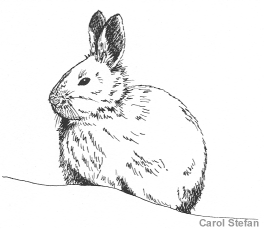

Charles J. Krebs, Stan Boutin, and Rudy Boonstra, Editors
In this book we describe the Kluane Boreal Forest Ecosystem Project which operated from 1986 to 1996 in the southwestern Yukon. We begin by describing the area and its physical setting, and then describe the background of the project and the wisdom that had accumulated to 1986 on how this system might operate. The details of the experiments we set up are presented, partly to help you appreciate the difficulty of working at -40o and partly to help you should you contemplate doing similar experiments in the future. Then we examine the three trophic levels of the plants, the herbivores, and the predators in detail and provide some surprises about how the individuals species operate within the overall system. Finally we synthesize these findings in a model of the boreal forest vertebrate community, and provide an overview of what we have discovered and what remains to be done. Over the ten years of this project 9 faculty members from three Canadian universities and 26 graduate students joined with 75 summer assistants and 18 technicians to expend 157 person-years of effort to produce the picture we develop here. No one ever thought that ecology was a simple subject like chemistry, but when we began this project we hoped to join forces to make a major advance in our understanding of the boreal forest ecosystem. Here is what we discovered.
[Oxford University Press, New York. 2001. ISBN 0-19-513393-5]
Chapter 1 General Introduction by Charles J. Krebs
Chapter 2 The Kluane Region by Charles J. Krebs and Rudy Boonstra
2.1 Geography and Geology
2.2 Weather and Climate
2.3 Study Area and Vegetation
2.4 Vertebrate Food Web
2.5 History of Hare Cycles
2.6 Large Mammals
2.7 Human Impacts
Chapter 3 Trophic Interactions, Community Organization, and the Kluane Ecosystem by A.R.E. Sinclair and Charles J. Krebs
3.1 Trophic-level Theory
3.2 Interactions of Trophic Levels
3.3 Experimental Perturbations in the Boreal Forest
3.4 Discussion
3.5 Summary
Chapter 4 Experimental Design and Practical Problems of Implementation by Stan Boutin, Charles J. Krebs, Vilis Nams, A.R.E. Sinclair, Rudy Boonstra, Mark O’Donoghue, and Cathy Doyle
4.1 Experimental design
4.2. Practical Problems of Implementation
4.3. Organization, Personnel and Equipment
4.4 Summary
Chapter 5 Plant Dynamics - Herbs and Grasses by Roy Turkington, Elizabeth John, and Mark Dale
5.1 Hypotheses Regarding Vegetation
5.2 Study Area
5.3 Tests of Predictions From Three Models
5.4 Which Model Best Describes Boreal Forest Herbs and Grasses?
5.5 Summary
Chapter 6 Plant Dynamics - Shrubs by Charles J. Krebs, Mark Dale, Vilis O. Nams, A.R.E. Sinclair, and Mark O’Donoghue
6.1 The Shrub Community at Kluane
6.2 Biomass Dynamics
6.3 Growth Rates of Shrubs
6.4 Losses of Twigs to Browsing and Natural Mortality
6.5 What Limits Primary Production of Shrubs?
6.6 Summary
Chapter 7 Plant Dynamics - Trees by Mark Dale, Shawn Francis, Charles J. Krebs, and Vilis Nams
7.1 Tree Community at KluaneChapter 8 Herbivores - Snowshoe Hare Demography by Karen Hodges, Charles J. Krebs, David Hik, Carol Stefan, Elizabeth Gillis, and Cathy Doyle
8.1 The Snowshoe Hare Cycle
8.2 Methods
8.3 Demographic Parameters
8.4 Impacts of Experimental Treatments
8.5 Interactions with Other Species
8.6 Conclusions
Chapter 9 Herbivores – The Rold of Red Squirrels and Arctic Ground Squirrels by Rudy Boonstra, Stan Boutin, Andrea Byrom, Tim Karels, Ann Hubbs, Kari Stuart-Smith, Mike Blower and Susan Antpoehler.
9.1 Natural History
9.2 Community Interactions and Factors Affecting Population Dynamics
9.3 Methods
9.4 Results
9.5 Discussion
9.6 Conclusions
Chapter 10 Herbivores - Voles and Mice by Rudy Boonstra, Charles J. Krebs, B.Scott Gilbert, and Sabine Schweiger.
10.1 Natural History and Food Web LinksChapter 11 Herbivores - Forest Grouse and Ptarmigan by Kathy Martin, Cathy Doyle, Susan Hannon, and Fritz Mueller
11.1 The Ecological Role of Forest and Alpine GrouseChapter 12 Other Herbivores and Small Predators: Arthropods, Birds, and Mammals by James N.M. Smith, and Nick Folkard.
12.1 MethodsChapter 13 Mammalian Predators: Coyotes and Lynx by Mark O'Donoghue, Stan Boutin, Dennis L. Murray, Charles J. Krebs, Elizabeth J. Hofer, Urs Breitenmoser, Christine Breitenmoser-Würsten, Gustavo Zuleta, Cathy Doyle, and Vilis O. Nams.
13.1 MethodsChapter 14 Other Mammalian Predators by Mark O’Donoghue, Stan Boutin, Elizabeth Hofer, and Rudy Boonstra
14.1 MethodsChapter 15 Avian Predators - Great-horned Owl by Christoph Rohner, Frank Doyle, and James N.M. Smith
15.1 MethodsChapter 16 Raptors and Scavengers by Frank Doyle, and James N.M. Smith
16.1 MethodsChapter 17 Testing Hypotheses of Community Organization for the Kluane Ecosystem by A.R.E. Sinclair, C.J. Krebs, R. Boonstra, S. Boutin, and R. Turkington
17.1 Experimental Perturbations of the Boreal ForestChapter 18 Vertebrate Community Structure in the Boreal Forest: Modeling the Effects of Trophic Interaction By David Choquenot, Charles J. Krebs, A.R.E. Sinclair, Stan Boutin, and Rudy Boonstra.
18.1 Trophic Interaction and Species CoexistenceChapter 19 Trophic Mass Flow Models of the Kluane Boreal Forest Ecosystem By Jennifer L. Ruesink and Karen E. Hodges.
19.1 Questions about the Ecosystem Dynamics of the Boreal ForestChapter 20 Conclusions and Future Directions by Charles J. Krebs, Rudy Boonstra, Stan Boutin and A.R.E. Sinclair
20.1 Primary FindingsAppendix 1. How to Use the Enclosed Kluane CD-ROM.
Appendix 2. Table of Conents for the Kluance CD-ROM.